Black art and artists are more important than ever right now. So as an art teacher – and home educating parent – it feels poignant and pertinent to both learn myself, and teach kids about black art and black artists.
Appreciating and understanding black and black artists will not only give us a more diverse and rich art education, but it will also help us to understand black culture, black people, black history and the issues black people are facing right now. It will allow productive conversation about discrimination and prejudice, and what we can do to help.
I have put together a list of just some of the black artists and black art that can engage and inspire children. Let me know what you think in the comments, share any work you do from this list, and feel free to offer any suggestions of other artists to follow – I am more than happy to say that I have a lot to learn on this subject and appreciate any ideas!
PART 2 – More Black Art & Artists to Inspire Kids is now available to read too – find it here!
Amy Sherald
Many of you will know Amy Sherald’s work, as she was the artist commissioned to paint Michelle Obama for the Smithsonian gallery. Sherald is an American artist based in Maryland, USA. She is best known from painting portraits of African-Americans and uses the paintings to tell their stories within their own tradition. Sherald documents a contemporary black experience through her paintings. She envisions black American identity beyond the conceits to which it has largely been restricted, attempting to restore a broader, fuller picture of humanity.
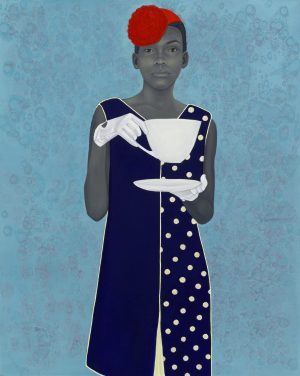
Amy Sherald uses a technique called Grisaille in her work, which is a technique whereby a painting is executed only in tones of grey – she does this as a way of challenging the concept of colour-as-race.
There is so much room for discussion whilst studying Sherald’s work. Talk about skin colours with your children and what their understanding of different skin colours are. Discuss the ideas of culture through fashion, colours, visual representation, and how people construct themselves based on their cultural and social history. (Yes, they are complex issues, and only you know how best to approach these issues with your own kids, or the kids you teach!)
Ideas to try:
- Explore colour mixing but with just one colour, using grey, brown, black and white to change the tones of the single colour. You could make a swatch card of all the tones you can make.
- Ask children to use this single colour to paint with, exploring the different tones within that one colour.
- Explore terms such as Grisaille (grey), Brunaille (brown), and Verdaille (green).
- Use swatches of fabric or cut outs from magazines etc. to create the clothing or accessories on a portrait they have painted.
- Try other mixed media paintings – mix grey pencil drawings with bold acrylic paint, for example.
- For older children explore the ideas of symbolism of colour, fashion and pattern in their painting.
Ruud van Empel
Ruud van Empel is a white, Dutch artist who uses composite photography techniques to create striking, surreal and beautiful portraits of fictional children in natural environments. The children are very often black, and depict innocence in the context of western ideals. You can read more about the work in this article on Africa’s Country.
“There was only one black boy in my primary school class. In the portrait Generation 1 (above) I expressed this situation. It shows a white class with just one black pupil. With World#1 I decided to work with more black children…The art historian Jan Baptist Bedaux told me this was the first time a black kid was portrayed as a symbol for innocence in Western Art.”
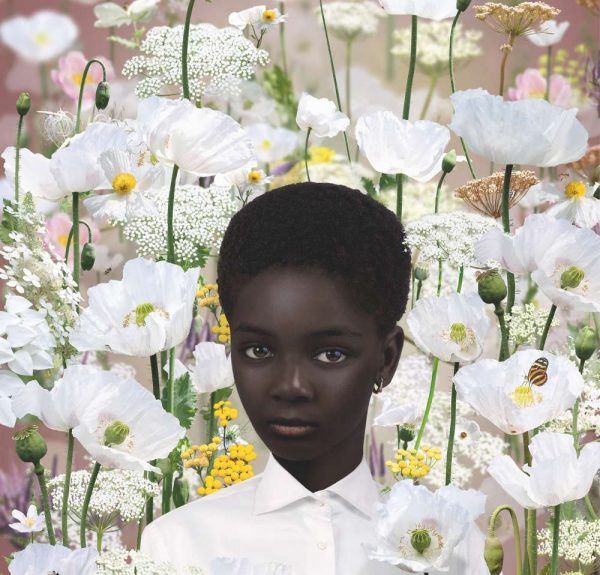
The work is complex from a social and political point of view, but for kids, it is a great way to talk about representation, western ideals, and different cultures, and how white people can advocate for black people in different ways.
Creatively, the work can inspire portrait photography and collage work. Composition, bold colours, filling an entire page, and combining portraits with nature are also elements that you can work with.
Ideas to try:
- Cut up portraits, nature and landscape from magazines and use them as collage materials. Ask the children to create a Van Empel style portrait.
- Ask children to use a camera or camera phone to take straight on portraits, asking their subjects to stare straight at the camera. Explore how this feels for photographer and model.
- Use the portraits and other landscape or nature photography and/or collage to create vibrant pictures, but cutting and sticking.
- For older children, use photo editing software (such as photoshop) to manipulate the photos digitally to create composite portraits.
Alma Thomas
Alma Thomas was an African-American expressionist painter and educator, best know from her colourful and vibrant abstract paintings. She was born in 1891 and died in 1978, she lived most of her life in Washington D.C, USA. Thomas is considered to have been successful despite her race and gender, however she herself did not turn to racial or feminist issues in her art, believing rather that the creative spirit is independent of race and gender.
Check it out – Mindful Art: Alma Thomas Inspired Painting

Alma Thomas created paintings (usually in watercolour) that focused on colour, rhythm and pattern that expressed her affinity with the natural world. For example, the picture above is titled ‘A Fantastic Sunset’. Thomas studied colour and other colour field painters, which, alongside having a rich mindful approach to the world around her, led her to create luminous, contemplative paintings, which have been celebrated around the world.
“Man’s highest aspirations come from nature. A world without color would seem dead. Color is life. Light is the mother of color. Light reveals to us the spirit and living soul of the world through colors.” – Alma Thomas Press Release – 1982
You can read more about Alma Thomas here. This work gives us the opportunity to look back in history and talk to our children about why Thomas would have faced so much discrimination as a black woman in the 20th century, and Thomas can serve as inspiration to rise above, create, to see the wonder in her wold, and be successful.
For old children – and adults – You could also have a discussion about whether black artists art work should or shouldn’t reflect the black experience specifically, or whether it can simply represent a human experience, for example, watching the sun go down… Does it matter? This is a complex issue and I don’t know what the answers are, perhaps there are no right answers here, but the conversation should be open for sure.
Ideas to try:
- A simple idea is to make a geometric mosaic with coloured squares of paper, and recreate one of Thomas’ vibrant art works.
- Mindful Art: Alma Thomas Inspired Painting
- A progression from this is to experiment with paint strokes to create an Alma Thomas inspired work. How can we make each paint stroke visible and vibrant? What paint works best for you? Acrylic, water colour, oils, pastels, and even pens would work well. Perhaps try a few and see what you enjoy.
- Go out with your children in nature and closely examine and experience an event, creature, plant or something else you can see… It could be the tide rolling in, a cluster of flowers, the sunrise, the snow falling, rain hitting a puddle… anything at all… take time to observe, make notes on how you feel, what you see, smell, hear… be mindful and focus solely on this one thing…
- Later, use this experience to inspire an abstract art work, use a medium you enjoy, and use bright colours. You do not need to try to recreate or paint the thing that you experienced, but use the feelings, colours, textures and anything else you felt were important to paint a representation of your experience.
Lubaina Himid
Lubaina Himid was born in Zanzibar in Tanzania, Africa. She came to the UK as a child, and was raised by her mother who was also an artist. When Himid started out as an artist she noticed that black people were not represented in the media or the arts. She became a member of the black arts movevent of the 1980s, making paintings, wooden cutouts and installations that explored black identity. In 2017, Himid made history by becoming the first black women, (and oldest artist), to receive the Turner Prize for contemporary art.
In an interview with The Tate Himid says that what inspires her is “people’s resilience and their determination to make the world a better place.”
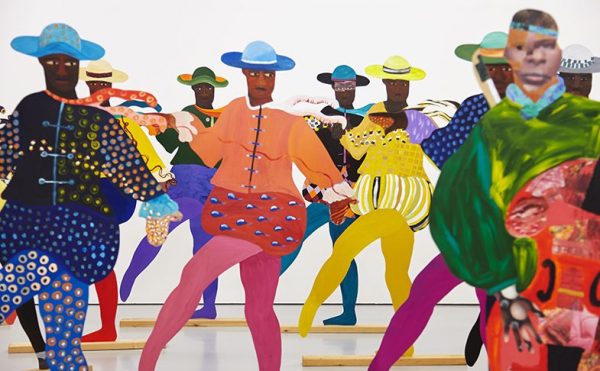
Himid was very interested in exploring how black people have influenced western society, and in telling stories about black women. A lot of Himid’s work was also about the friendship between black women and how this changed their lives, and shaped their identity as black women. She was influenced by fabrics and textiles, and what they could uncover about culture and history.
This article from Tate Kids is really useful for exploring Himid’s works with your kids.
Exploring Himid’s work is a key point into discussing and learning more about how black, especially African, culture has influenced like in western countries like Britain and America. Fashion is an easy visual association for children to understand, and is poignant in Himid’s work.
Himid’s work also gives us inspiration to appreciate the empowerment of people – from the Black Arts movement, where Black artists gave each other opportunities and boosted each other, to the stories of friendship and loyalty within black women’s culture. How can you delve into these issues more deeply? How does it relate to your kids?
Ideas to try:
- Take a look at the second page of this useful PDF from ModernArtOxford, and design a Kanga.
- Have you some old clothes or blankets lying around? Consider cutting them up into smaller pieces, and then either sewing a new piece of fabric from the pieces, or simply collaging them. Discuss what the pieces of fabric say about you, or your family and culture.
- Simply ask your child to make a picture about them and their friend or friends.
- Take a roll of paper, old sheet, or stick sheets of paper together to make piece large enough for your children to lie on. Have them draw around each other, or you can do it. Then ask them to use bold colours, or collage to create a self portrait that expresses themselves. When finished, ask them to cut it out and tack it to a wall so they can experience their self portrait up close and life-size.
- For a more long term activity, and perhaps for older children, ask them to collect fabrics over time that they relate to or connect with, and once they have enough create a “quilt”, art piece, or fabric book that expresses their own experiences.
Wadsworth Jarrell
Wadsworth Jarrell is an African-American painter, sculptor and printmaker. He was born in Georgia, USA, and lives and worked in Chicago, Illinois, USA, where he explored the working life of black people, and is heavily influenced by Jazz music, and became involved in the Organisation of Black American Culture, during the 1960s – a time of a huge social movement in America, working towards anti-racism.
CHECK THIS OUT —- How to Make Sun Art Inspired by Wadsworth Jarrell
Jarrel then lived in Africa, and in various other places in America. He moved around and had a lot of involvement in social movements and taught in many different places.
Wadsworth’s wife, Jae Jarrell, was also an artist, and you can read more about here in, More Black Art & Artists to Inspire Kids
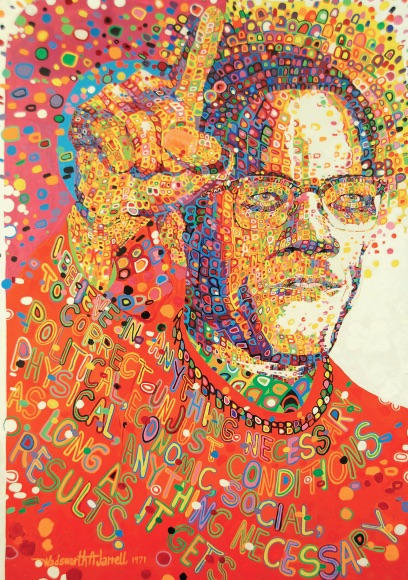
This is a great article on Jarrell’s work, which I highly encourage you to read. Here are some key points about his work.
Jarrell often made portraits of important and powerful black people, such as the picture above, which is a portrait of Macolm X, who made huge contributions to the civil rights movement, and who dedicated his life to empowering the black community.
Jarrel uses a mix of bold, vibrant colours that reflect African textiles, and the vibrancy of African-American cultures, and repetitive, rhythmic patterns and letters or words. He explores contemporary African-American life, using both African and Western motifs, and expressive paint strokes, which both evoke an emotional response from the viewer, and represent liberty.
Ideas to try:
- Ask children to make a portrait of someone who inspires them.
- More specifically, encourage use of bold and vibrant colours, and thick brush strokes to express how they feel about this person.
- Children can also use collage and paper mosaic techniques to create their portrait.
- Ask them to make the portrait using words to create the shapes in or around the portrait, and to use words that are empowering – that lift people up and make them feel capable and powerful.
- Jarrell used a trowel (like you use to plaster cement onto a wall) – what can you use to paint with, instead of a paintbrush? How about a butter knife, a spatula, a fork, or even something huge like a spade?
Carolyn Mims Lawrence
Like Wadsworth Jarrell, Carolyn Mims Lawrence was one of the artists who contributed to the Wall of Respect as part of the Organisation of Black American Culture, and later on she was a member of afriCOBRA, which sought to define a Black aesthetic and create positive, empowering images of Black life. You can read more about that here.
Art and artists can be a way to interpret how race affects everyone. Our images are a healing force against negative images that are an assault upon the minds of Black people… Our images reinforce what is already naturally authentic about us and call us to love ourselves. – Carolyn Mims Lawrence

Carolyn Mims is most famous for this painting, titled, ‘Black Children Keep Your Spirits Free’ (1972). This painting uses bold acrylic colours alongside an emboldened mantra to create a statement work of art to empower young black people, and which seeks to encourage and represent freedom and expression of African-American culture and community.
Ideas to try:
- Can your children create a colour palette that represents their family, school, groups of friends, or community?
- Look at the background of the painting above, notice the shapes, colours and patterns. Ask children to create an abstract painting using a variety of shapes, patterns and bold colours.
- Ask children to think of a mantra that will help their friends, family, or community. Encourage them to repeatedly write or paint the mantra using bold lettering (stencils may help younger children) over a canvas, or large piece of paper. They could do this over the top of the abstract piece, or as a standalone piece. Explore different ways of presenting the words.
- For older children, ask them to make a picture in the style of Mims, that shows people in their community, family, school or friendship group. Ask them to combine abstract elements; text and portrait paintings to create this.
- Consider facilitating a mural – allow children to work together to create a community, school, or family mural that spreads a positive message.
Read Part 2 – More Black Art & Artists to Inspire Kids here.
If you would like to share this post, please use the image below. Thank you!

I hope these 6 artists and their work will give you some inspiration in your home or classroom! I’d love to see any work that you or your children create from this; I’m always happy to read comments or emails!
Now read part 2 – More Black Art & Artists to Inspire Kids!
Much love,









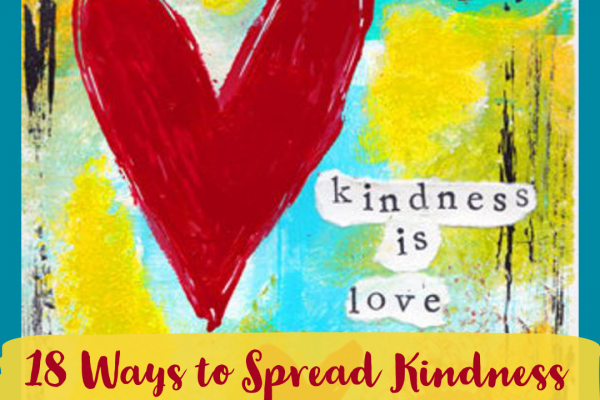

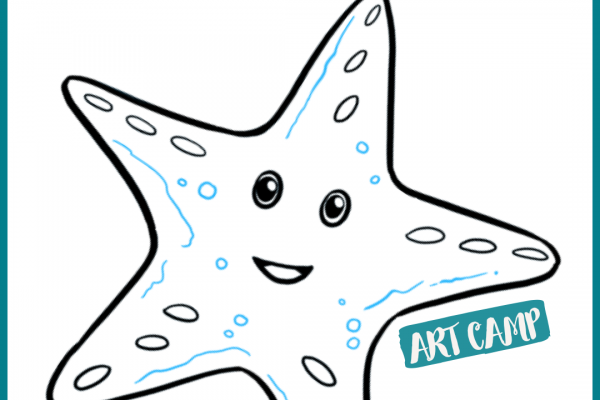

that was fun